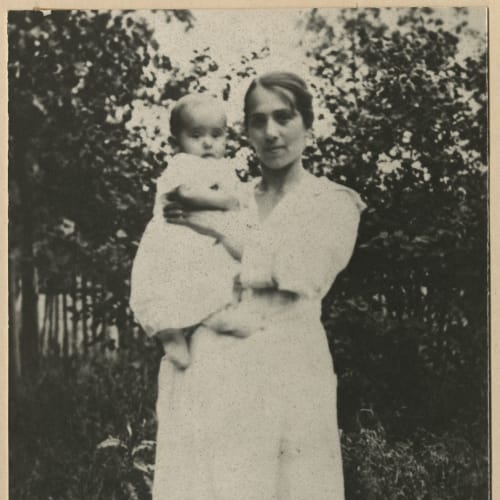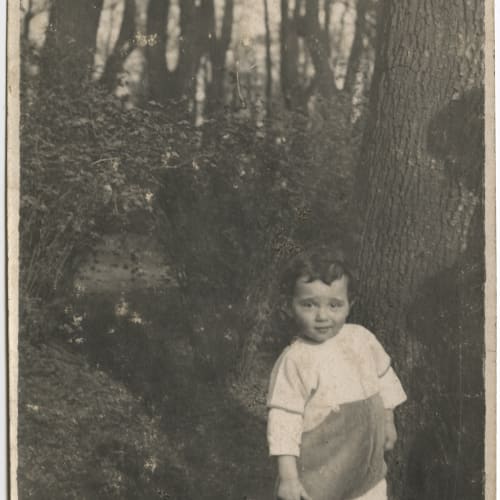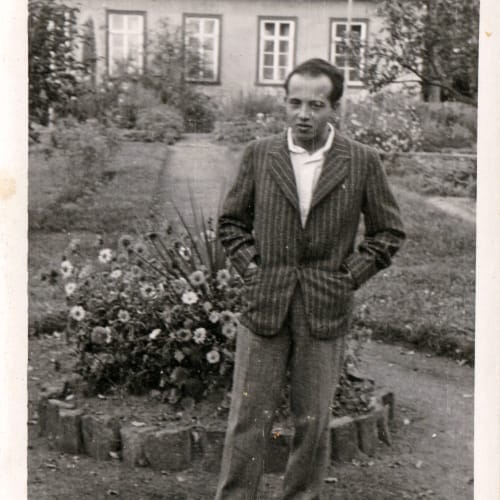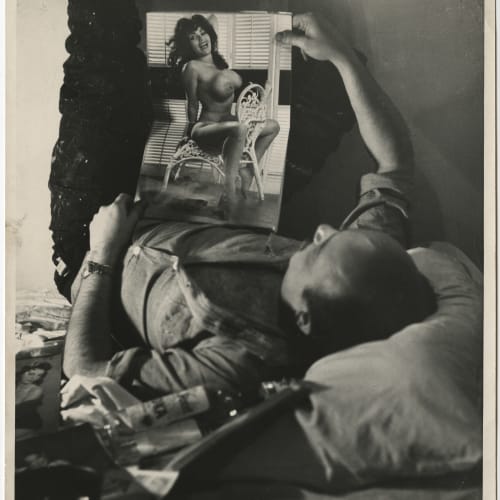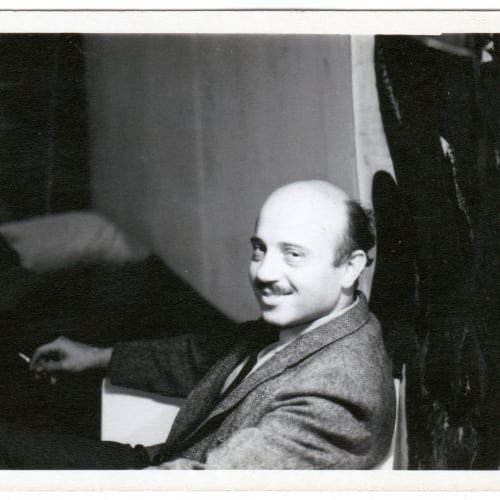1924 Born on July 18th in Leningrad, Russia to Schaina and Ilya Lurje. His mother was a radical socialist Zionist and a dentist, his father was a successful business man. He had two older sisters, Assya and Josephina (Jeanne).
1925 After the death of Lenin, his father's plant was seized. First Ilya, then Schaina and the children, fled the USSR for Riga, Latvia. He attended a German-speaking gymnasium, where he learned English and caused mischief. His artistic abilities were first noticed by his mother's cousin, a commercial artist.
1937 Produced his first self-described masterpiece, a nude.
1940 Latvia was annexed into the Soviet Union, putting the Lurie family back under the jurisdiction of Stalin. During the Year of Terror almost 35,000 Latvian citizens were deported or killed by the Soviets.
1941 The Nazis entered Latvia on June 22. The Luries occupied an apartment in a building on Stabu Street, as did the family of his schoolmate, Ljuba Treskunova, forced from their Meza-Parks villa. They spent every day together, in love.
On October 25 the Nazis relocated all Jews from Riga and environs to the newly designated Large Ghetto.
On November 29 women, children, and the elderly were evacuated from the ghetto. On November 30 approximately 13,000 people were marched 10 km in the cold to the Rumbula forest, where they were forced to strip naked, walked into the murder pits, and shot. On December 8, another 12,000 people were marched to their deaths in Rumbula, among them Lurie's grandmother; mother, Schaina Lurje; sister, Josephina Lurje; and Ljuba Treskunova.
1941-1945 Boris and Ilya Lurie were imprisoned in the Riga Ghetto, the Lenta Arbeitslager, and the Salaspils, Stutthof, and Buchenwald-Magdeburg concentration camps.
1945 On April 18, Magdeburg was officially liberated. Lurie and his father were discovered by Dino Russi, his sister Assya's husband, who worked with the U.S. Counter Intelligence Corps.
1946 On June 18, father and son arrived in New York, where the younger Lurie began drawing and painting images from his memories of the war.
1947 Began the Dismembered Women series.
1948 Attended the Art Students' League, studying with Reginald Marsh and George Grosz.
1950 Had his first solo shows at Creative Gallery and the Barbizon Plaza Galleries, New York.
1951 Met Béatrice Lecornu (Hamilton), whom he would marry.
Returned to Europe for the first time. In Paris he met the artists Louis Aragon, Francis Salles, Wols, and Pierre Soulages.
Expanded the Dismembered Women series, creating large scale murals, exhibited at the Barbizon Plaza Galleries and at Marino Art Gallery.
1954-1955 Spent much of his time in Paris. Shared a studio with artist Ed Clark. Met Sam Francis, Beauford Delaney, and Chester Himes.
Visited Israel for the first time.
In New York, he found occasional commercial work in fashion illustration.
1956 Met Sam Goodman at the Cedar Tavern.
1957 Helped establish the March Gallery, one of the 10th Street cooperative galleries, with friends Rocco Armento, William Gambini, and 21 others.
1959 Began to make the NO!art collage and transfer works.
Met Stanley Fisher while Fisher was compiling his anthology of Beat literature, entitled Beat Coast East, one of the earliest anthologies devoted to the Beats, in which Lurie appears.
Established the NO!art movement with Sam Goodman and Stanley Fisher. The movements protested against wars and nuclear armament and decried the ascent of propaganda and dehumanization of consumer culture. Harold Rosenberg described the work as "Pop, with venom added" without really grasping their mission.
1960 Together with Sam Goodman and Stanley Fisher, took over the leadership of the March Gallery from Elaine De Kooning.
Lurie and Béatrice Lecornu divorce.
In Paris attended the opening of the large-scale protest exhibition Anti-procès in support of Algerian rights, with 60 total artists, where he was introduced to the organizer, Jean-Jacques Lebel, through his friend Erró.
The March Group presented the first canonical show of NO!art, the Vulgar Show.
1962 Traveled to Italy for the two-man Doom Shows (Boris Lurie and Sam Goodman) at Galleria Schwarz in Milan and Galleria La Salita in Rome. Met Enrico Baj, among others.
Returned home to meet Gertrude Stein; the two would become lovers, partners, and friends for the rest of his life.
1963 Gallery: Gertrude Stein opened with a show of Boris's Multiplications. He oversaw much of the programming, including the NO Show.
1964 NO Posters: ANTI-POP show, and with Sam Goodman arranged the infamous NO-Sculpture (Shit Show), both at Gallery: Gertrude Stein.
The death of Ilya Lurie on June 9, 1964, caused him to pause making art.
1970s After his art-making interruption, Lurie reentered the artworld with exhibitions: Art & Politics, Kunstverein Karlsruhe, Germany, NO!art-Painting seit 1959, Galerie René Block, Berlin and Boris Lurie, at Galleria Giancarlo Bocchi, Milan.
1972 Works on the Hard Writings Series.
1974 Solo exhibitions at Galerie Inge Baecker, Bochum and shows NO!art Bags, Galerie und Edition Hundertmark, Cologne; Boris Lurie and Wolf Vostell, Galerie Rewelsky, Cologne; NO!art with Boris Lurie, Sam Goodman and Marcel Janco, Ein-Hod Museum, Ein-Hod, Israel.
1975 Returned to Riga for the first time since 1944, which motivated him to begin writing a memoir, In Riga, which he worked on for the next thirty years.
Focused on writing, including his novel, House of Anita.
1978 Exhibitions: Counterculturale Art (with Erró and Jean-Jacques Lebel), American Information Service, Paris.
1980s Expanded and continued work on Feel paintings which he began in the early 1950s.
1987 Published, in collaboration with Seymour Krim, NO!art: Pin-Ups, Excrement, Protest, Jew-Art, Edition Hundertmark
1989 Exhibitions: On the wall / Graffiti between Anarchy and Gallery, Nassausicher Kunstverein, Wiesbaden.
1990s Worked on his memoirs, as well as on the novel House of Anita, both published posthumously.
1993 Exhibitions: Outlaw Art Show, Clayton Gallery, New York.
1994 Exhibitions: NO!art (with Isser Aronovici and Aldo Tambellini), Clayton Gallery, New York.
1995 Exhibitions: NO!art, Neue Gesellschaft für bildende Kunst; Boris Lurie und NO!art, Haus am Kleistpark; Dance Hall Series, Endart Galerie, all in Berlin and Holocaust in Latvia, Jewish Culture House in Riga.
1998 Exhibitions: NO!art Show #3 (with Dietmar Kirves, Clayton Patterson and Wolf Vostell), Janos Gat Gallery, New York.
1999 Exhibitions: Works 1946-1998, Leben-Terror-Geist, (Life-Terror-Mind), Memorial Gedenkstätte Weimar-Buchenwald; and Knives in Cement, South River Gallery, (UIMA), Iowa City.
2002 Exhibitions: NO!art and The Aesthetics of Doom, Iowa Museum of Art, Iowa City and Block Museum, Evanston, IL.
2003 Publication of his poetry collection Boris Lurie: Geschriebigtes/Gedichtigtes for the exhibition held at the Buchenwald memorial site near Weimar in 1999.
Created the Ax Series with Rocco Armento in Woodstock, NY.
2004 Exhibitions: Feel Paintings/NO!art Show #4, Janos Gat Gallery, New York; Optimistic-Disease-Facility, Boris Lurie: New York-Buchenwald, Haus am Kleistpark, Berlin with Naomi Solomon.
2005 Exhibitions: The '80s, Clayton Gallery and Outlaw Art Museum, New York.
2008 On January 7 Boris Lurie died in New York.
